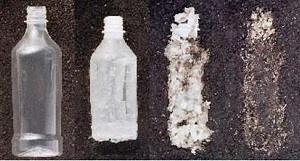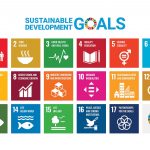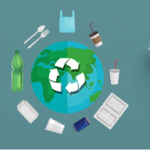Biodegradation, Compost, and the Future of Bioplastics
By Emily Wu, Bethesda Green Environmental Leader
As the detrimental effects of plastics, especially single use plastics, become more and more apparent, many countries, states, and cities are starting to ban the use of single use plastics. In the wake of these bans, people and businesses are increasingly looking towards plastic alternatives made compostable or biodegradable materials instead.
But what is the difference between compostable and biodegradable? These two words are often used interchangeably when describing sustainable materials and packaging, but there is a key nuance to these descriptors. Biodegradable is defined by the American Society for Testing and Materials (ASTM)—an international standards organization that develops and publishes technical standards on various materials and products—as materials that can be broken down in the natural environment by naturally occurring microorganisms into “biomass, water, carbon dioxide, and/or methane.” Compostable, on the other hand, describes materials that can be broken down through biological processes into biomass, water, carbon dioxide, and inorganic compounds without leaving behind any toxic residue. However, many compostable materials, particularly compostable plastics, require special facilities that allow them to break down. This means that while biodegradable materials are compostable, not all compostable materials are biodegradable.

Image Source: Eventige
So why does this matter? The difference between compostable and biodegradable becomes especially relevant when discussing compostable plastics due to misconceptions and incorrect disposal of these products. Compostable plastic products are one of the most common plastic alternatives that people have started to use, usually in the form of single use products such as utensils and take out containers. Many of these single use products are made from PLA, polylactic acid. PLA is perhaps one of the most well-known types of compostable plastics, as well as the most widely used. However, PLA, while technically “compostable,” is not “biodegradable.” PLA is a type of compostable plastic made from plant starches, typically corn, and is only compostable in a certain industrial environment. This means that PLA is not compostable in a typical home composting system, nor does it biodegrade in a natural environment. As an alternative for single use plastics, this is a concern since a lot of single use plastics end up in the environment and waterways.
While this seems like a rather bleak future for the application of bioplastics for sustainability, there is research being done on alternatives that can mitigate many of the negative qualities of PLA plastic. There is another type of bioplastic known as PHA, a family of biodegradable polymers derived from bacteria. Unlike PLA, which is processed from starches, PHA is created through the fermentation of carbohydrate feedstocks, such as canola oil, in bacteria to form polymers that are then extracted and made into thermoplastics. This type of plastic is much more biodegradable and degrades faster than PLA, because the source of these polymers is preexisting in nature and is an energy source used by many different species of bacteria. When introduced to a natural environment such as soil or marine, the microorganisms in these environments can utilize these polymers and break them back down. In fact, PHA is the only class of biopolymers that exhibit efficient marine degradation according to ASTM standards, unlike PLA which does not degrade in a marine environment.

Image source: Bio Based Press
Of course, while PHA has been shown to be more biodegradable than PLA, there are still certain drawbacks. Unlike PLA, the production and processing of PHA resin is much more expensive, and a narrow processing window makes this plastic more difficult to work with, limiting its current applications. In addition, while PHA is more decomposable than PLA, in an unideal environment, such as a landfill, the uncontrolled anaerobic decomposition of PHA releases harmful gases such as methane, which can increase greenhouse gas pollution and contribute to climate change.
Still, the sustainable traits that PHA exhibit makes it an attractive alternative for single use plastics. With more research, PHA can become a commonplace, environmentally sustainable material. In fact, in 2021, the U.S. The Department of Energy has proposed to provide funding to the University of Maryland to conduct and lead experiments on the usage of food waste in the production of PHA to increase the value and use of this plastic.
The misconceptions and misleading labeling of packaging and products as “biodegradable” or “compostable” has led to people disposing of these products in a way that is just as damaging to the environment as regular plastic products. However, this is not the end for sustainable bioplastics. We can ensure that the compostable plastic products that we use are sent to the proper facilities and learn about whether the packaging or product used is actually home compostable or biodegradable. While we have a responsibility to abstain from single use plastics, a dedicated environmentalist will take this commitment one step further and ensure that they properly dispose of their plastic alternatives.
Works Cited
C&EN, cen.acs.org/business/biobased-chemicals/PHA-biopolymer-whose-time-finally/97/i35.
ASTM International – Standards Worldwide, www.astm.org/.
By: Diederik van der Hoeven on: 21 August 2016. “PHA: Promising, Versatile, Biodegradable.” Bio Based Press, 1 June 2020, www.biobasedpress.eu/2016/08/pha-promising-versatile-biodegradable/.
Cho, Renee. “The Truth about Bioplastics.” Phys.org, Phys.org, 14 Dec. 2017, phys.org/news/2017-12-truth-bioplastics.html.
“Corn Plastic to the Rescue.” Smithsonian.com, Smithsonian Institution, 1 Aug. 2006, www.smithsonianmag.com/science-nature/corn-plastic-to-the-rescue-126404720/.
“Polyhydroxyalkanoate.” Polyhydroxyalkanoate – an Overview | ScienceDirect Topics, www.sciencedirect.com/topics/chemistry/polyhydroxyalkanoate.
Rick Lingle | Apr 10. “PHA Bioplastics a ‘Tunable’ Solution for Convenience Food Packaging.” Plasticstoday.com, 1 July 2020, www.plasticstoday.com/packaging/pha-bioplastics-tunable-solution-convenience-food-packaging.
Source, Free Polymer Information. “Polymer Properties Database.” PHA Suppliers, polymerdatabase.com/Polymer Brands/PHA.html.
Team, Content. “The Truth About Biodegradable Plastic Packaging.” Eventige, Eventige Media Group, 30 Jan. 2021, www.eventige.com/blog/biodegradable-plastic-packaging.
W. Meereboer, Kjeld, et al. “Review of Recent Advances in the Biodegradability of Polyhydroxyalkanoate (PHA) Bioplastics and Their Composites.” Green Chemistry, Royal Society of Chemistry, 17 Aug. 2020, pubs.rsc.org/en/content/articlehtml/2020/gc/d0gc01647k.
About the Author:
 Emily Wu, Bethesda Green Environmental Leader
Emily Wu, Bethesda Green Environmental Leader
Emily is a Senior at Walt Whitman High School. She is interested in many environmental issues, mainly how global warming and pollution impacts the organisms in our ecosystems and environments, as well as how the global changes are affecting life for humans.





